



This research was funded by iMOVE CRC and supported by the Cooperative Research Centres program, an Australian Government initiative. RAILWAY STATION PLATFORM GAP SOLUTIONS PROJECT 1-056 /
1.
CONTENTS
The current platform gap 7 2. The current solution: Manual ramp 13 3. Australian vs International Standards 31 4. Solutions 37 5. Automated solutions 43 Conclusion and next step 67
The pictures throughout the book are crowd sourced using Facebook – over 80 pictures of locations with significant gaps were uploaded

“[I have] absolutely no chance of navigating this on my own”
– Alison Moreno, Facebook Comments, December 2022
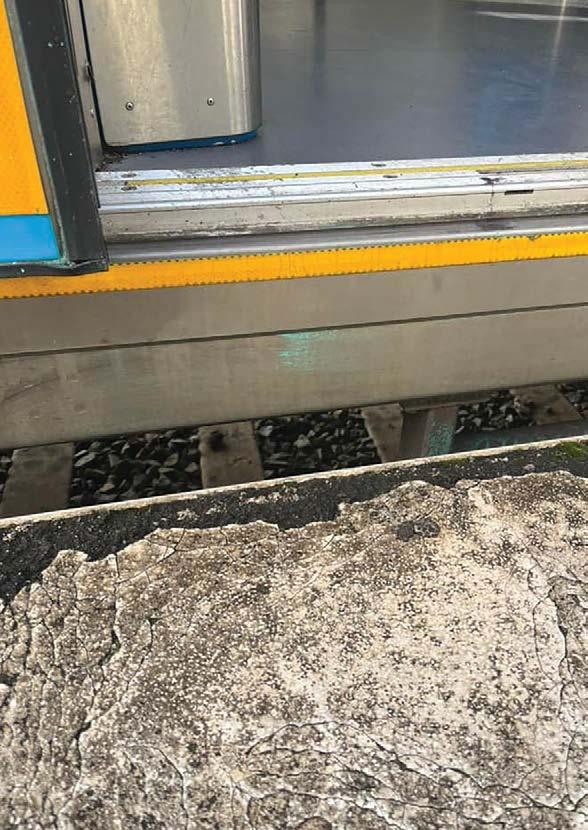

2 RAILWAY STATION PLATFORM GAP SOLUTIONS
Saumya Kaushik, Newport, VIC
Nae Rocca, Broadmeadows, VIC
Using trains should be easy for everyone.
Due to gaps between rail platforms and trains it is not easy for many people with disability (and poses a risk for other travellers too).
The current solution, a manual ramp, is far from ideal.
Automated ramps can provide unassisted access to trains. They can bridge the height and depth and even accommodate stopping inaccuracies of trains.
This report shares the findings from our engagement with industry and people with disability around their experience with gaps, manual ramps, and the Australian standards for gaps.
We tested 3 working prototype ramps which were – not surprisingly – received well by people with disability. The proposed next step is to test these ramps in controlled operational conditions.
3 RAILWAY STATION PLATFORM GAP SOLUTIONS
We engaged people with a variety of disabilities


4 RAILWAY STATION PLATFORM GAP SOLUTIONS
We engaged people with a variety of disabilities
> BKA on right leg, travel mainly in PWC
> Power wheelchair dependent due to Multiple Sclerosis have to use mobility aids wheelchair/rollator
> Physical Disability and use an electric wheelchair
> Right Above Knee amputee/Manual wheelchair user
> C4 quadriplegic
> Muscular Dystrophy using a power wheelchair
> Cerebral Palsy
> Paraplegic + R arm amputation
> I have autism epilepsy and add
> Spinal Injury
> Spinal Cord Injury
> Spina bifida
> Physical, spina bifida
> Cerebral palsy
> Hidden disability
> physical, autonomic
> paraplegic + R arm amputation
> I have autism epilepsy
> Spinal Injury
> Spinal Cord Injury
> Spina bifida
> Physical, spina bifida
> Cerebral palsy
> Hidden disability
> physical, autonomic
> Double amputee
> Physical & neurological
> Physical - Spina Bifida
> F ully wheelchair dependent, spina bifida.
> I have Ehlers Danlos, Dysautonomia and COPD so my ability to walk varies. If I am travelling alone it’s almost always with my electric wheelchair
> Physical disability caused by Cerebral Palsy
> Cerebral palsy (fully wheelchair bound)
> Cerebral palsy
> C5/6 quad incomplete
> I have SMA
> Physical disability. Basically, a quadriplegic so, use a power wheelchair.
> Ehlers Danlos Syndrome and Functional Neurological Disorder
> Joint and heart issue uses a manual wheelchair on long days.
> Physical and neurological
> MS
> Paraplegic
> I use a motorised scooter while traveling on the train.
> Parinaud syndrome (can only focus with one eye at a time, attention jumps between eyes erratically), mild cerebral palsy (weaker left side, trips over uneven gaps in pavement)
> Parinaud Syndrome (aka ‘Dorsal Midbrain Syndrome’, mild Cerebral Palsy)
> Physical and Neurological
> Use manual wheelchair
> Genetic connective tissue disorder and autonomic dysfunction, ambulatory manual wheelchair user
> Paraplegic
> Cerebral Palsy
> T4 Paraplegia
> Multiple sclerosis
> Mobility impairment post stroke
> ME/CFS
> Physical impairment
> 12-year-old semi-ambulant user utilises wheelchair for pain reduction due to foot/ankle deformity due to taipes. Survey being completed by mother
> Strokes drop foot
> Physical disability
> Cerebral Palsy
> Physical. Manual wheelchair userMy 11-year-old child has a disability, she is an ambulant wheelchair user so fatigues easily and has balance issues and intellectual disability. I am answering these questions as the person who mobilises her in the wheel chair – she does not self mobilise
5 RAILWAY STATION PLATFORM GAP SOLUTIONS
“I’m too scared to even get off (at) this station”
– Nicole Featherstonehaugh, Facebook Comments, August 2023



6 RAILWAY STATION PLATFORM GAP SOLUTIONS
Wayne Townsend, Essendon, VIC
Alison Moreno, Yarraville, VIC

The current platform gap 1/
7 RAILWAY STATION PLATFORM GAP SOLUTIONS
Wayne Townsend, Essendon, VIC
Not just for people with disability, but a safety risk for all passengers: According to new data, there were more than 380 slips, trips and falls across the city’s train network in the past year.
More than half of those resulted in injuries and trespassing was the most common safety risk.
Every mishap has the potential to cripple the entire network and potentially affect about 50,000 commuters.
(9News, 2022)


8 RAILWAY STATION PLATFORM GAP SOLUTIONS
Haylee Tumanik, Eastwood, NSW
The current problem
Many users find it difficult to cross the gap between train and platform.
I feel unsafe/fearful to get stuck or fall when crossing the gap between the train and platform (%, n = 82)
Source: La Trobe University, quantitative ramp survey, 2023
9 RAILWAY STATION PLATFORM GAP SOLUTIONS
Strongly disagree2 3 4 Neither 6 7 8 9Strongly agree 16% 12% 11% 6% 6% 4% 10% 5% 26% 5%
–
“I wonder how many wheelchairs are under there”
2023
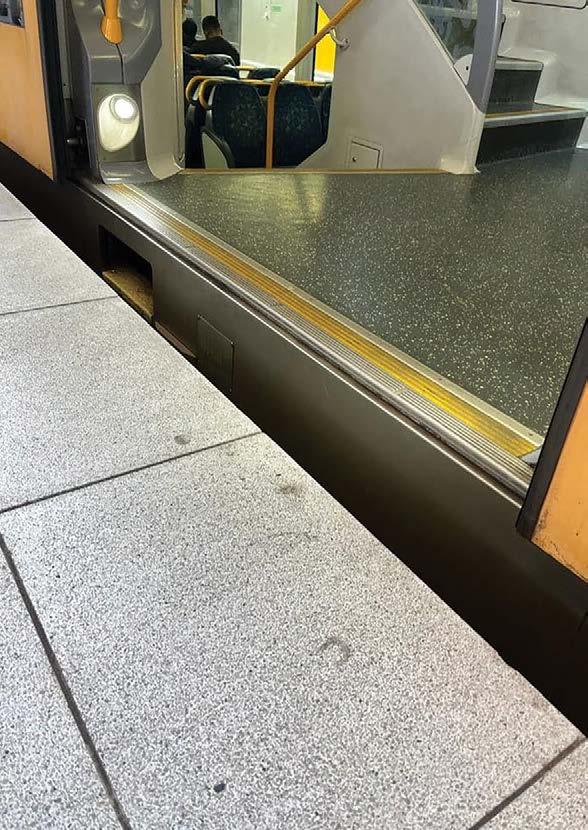
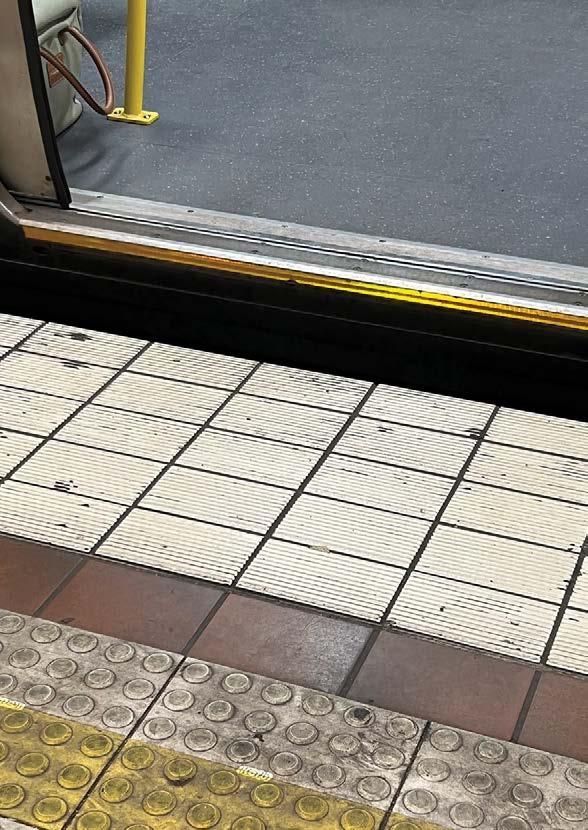

10 RAILWAY STATION PLATFORM GAP SOLUTIONS
Julie Duong, Central, NSW
Leonard Mammoliti, Melbourne Central, VIC
Astrid Van Dyke, Facebook Comments, July
The current problem
Many users find it difficult to cross the gap between train and platform. Because of the gap in between the train and the platform, it is difficult to alight and board trains at many train stations (%, n = 68)
Source: La Trobe University, quantitative ramp survey
11 RAILWAY STATION PLATFORM GAP SOLUTIONS
Strongly disagree2 3 4 Neither 6 7 8 9Strongly agree 4% 4% 4% 16% 16% 8% 40% 0%0% 8%
“Sometimes there’s a little gap and drivers insist on just crossing, even when I know it isn’t safe”


12 RAILWAY STATION PLATFORM GAP SOLUTIONS
– La Trobe Modtas Survey, 2023
Zoe Phelan, Collingwood, VIC
The current solution: Manual ramp 2/


13 RAILWAY STATION PLATFORM GAP SOLUTIONS
Mo’nique Witsen, Quakers Hill, NSW


14 RAILWAY STATION PLATFORM GAP SOLUTIONS
Freya Elliott, Epping, VIC
The Manual ramp
The solution is working but it is not ideal…
Source: La Trobe University, quantitative ramp survey, 2023
I am satisfied with the current manual ramp solution for the train-platform gap (%, n = 61)
15 RAILWAY STATION PLATFORM GAP SOLUTIONS
77% 23%
Disagree Agree
“It’s shameful. Basically no consideration for disabled or wheelchair users.”
– Astrid
Dyke, Facebook Comments, August 2023



16 RAILWAY STATION PLATFORM GAP SOLUTIONS
Van
Wayne Townsend, North Melbourne, VIC
Lily Lee, Auburn, VIC
The Manual ramp
Something goes wrong regularly for one third of ramp users
How often does something go wrong with boarding or alighting from the train using the manual ramps? (%, n = 72)
Source: La Trobe University, quantitative ramp survey, 2023
17 RAILWAY STATION PLATFORM GAP SOLUTIONS
Never Seldom Regularly Often Always 18% 46% 22% 40% 40% 40% 11% 40% 3%
“I’m too scared to even get off (at) this station”
– Nicole Featherstonehaugh, Facebook Comments, August 2023
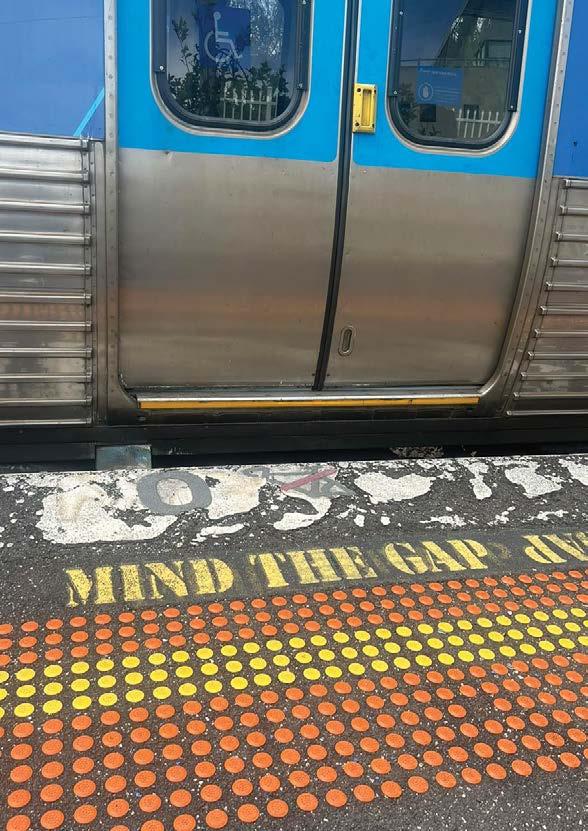


18 RAILWAY STATION PLATFORM GAP SOLUTIONS
Wayne Townsend, Essendon, VIC
Alison Moreno, Yarraville, VIC
The Manual ramp
Something goes wrong regularly...
In Melbourne it is hard to locate (at the train stations) where you need to be to get assistance i.e a staff member to get the ramp for you. It’s not like you can easily move around to find someone to assist you. There is also an issue of when trains pull in and they are crowded so there is no room to get on the train - you get left at the station
Rail staff forget to get the ramp at the end of the trip and a passenger has had to notify the train staff on the platform to let me off the train
There’s not enough room on the ramp (not wide enough), so I need help to steer. It’s also far too steep an incline and I never feel safe. There are “mini steps”/”ledges” to get on the ramp to get off the train, so I have to go backwards, which makes everything way worse!
1) Ramp isn’t placed down correctly so it moves 2) I have had an instance where the CSA used his foot to keep the ramp in place by placing his foot on the side of the ramp to which as I was rolling down the ramp my front castor hit his foot and my chair tipped, causing me to flip out of my chair and hit my face on the platform floor. 3) Train doors have also been closed on me whilst trying to alight a train whilst using a manual ramp. I’m sure there’s other examples but that’s just a few of my experiences
Wheelchair front wheels get stuck at ramp lip from the platform so my partner pushes my chair over the lip
Source: La Trobe University, quantitative ramp survey, 2023
I know it sounds dumb but if I’m on my own I always get stuck. It’s better if staff assist me but I get scared in case I get abused. The new ramps here in NSW is wider and flatter but has a split in the middle of ramp looking as if about to break.
19 RAILWAY STATION PLATFORM GAP SOLUTIONS
“Sometimes drivers just ignore me and head off”



20 RAILWAY STATION PLATFORM GAP SOLUTIONS
– La Trobe Modtas Survey, 2023
Sonya Marshall, Martin Place, NSW
Alison Moreno, Southern Cross, VIC
The Manual ramp
Most importantly, many users struggle with independence
Getting a manual ramp organised for me is easy (%, n = 81)
21 RAILWAY STATION PLATFORM GAP SOLUTIONS
Strongly disagree2 3 4 Neither 6 7 8 9Strongly agree 16% 7% 6% 10% 14% 7% 11% 9% 19% 1%
Source: La Trobe University, quantitative ramp survey, 2023
–
“There has been times where I have made eye contact with the train driver, but they’ve just ignored me”
Ramp Survey, 2023


22 RAILWAY STATION PLATFORM GAP SOLUTIONS
La Trobe
International)
John Robert McPherson, Sunnybank Railway Station, QLD (Creative Commons Attribution-Share Alike
4.0
Most importantly, many users struggle with independence I feel embarrassed when staff help me to alight or board a train (%, n = 75)
Source: La Trobe University, quantitative ramp survey, 2023
23 RAILWAY STATION PLATFORM GAP SOLUTIONS
Strongly disagree2 3 4 Neither 6 7 8 9Strongly agree 24% 5% 4% 3% 11% 0% 12% 4% 33% 4%
“It’s scary to use, especially when it doesn’t lock in and the driver just holds it in place with their foot”
2023


24 RAILWAY STATION PLATFORM GAP SOLUTIONS
– La Trobe Ramp Survey,
Bernhard Rüger, Manual mobile Ramp (Port-a-Ramp, UK) (Image may be subject to copyright.)
The Manual ramp
For the operator it takes time…
On average, how long would you estimate it takes to set up and use a manual ramp while boarding or alighting from the train, from the moment the train stops? (%, n = 61)
Less then a minute
1-2 minutes
More than 2 minutes
Unsure
25 RAILWAY STATION PLATFORM GAP SOLUTIONS
3% 28% 59% 10%
VIC

“Sometimes the ramp drops, and I can’t even get over the edge”
– La Trobe University, Quantitative ramp survey, 2023


26 RAILWAY STATION PLATFORM GAP SOLUTIONS
Ella Bibby, Flinders St, VIC
Kayden Lee, Westona,
The Manual ramp
…and is a health and safety risk for people who deploy the ramp ‘I don’t know the exact Injury Statistics, but certainly, when I last spoke several years ago were retrieved typically, one staff member every month with the use of manual ramps. So that’s one of the drawbacks of manual ramps.’
Rail operator
27 RAILWAY STATION PLATFORM GAP SOLUTIONS

“There has been times where I have made eye contact with the train driver, but they’ve just ignored me”
– La Trobe Ramp Survey, 2023


28 RAILWAY STATION PLATFORM GAP SOLUTIONS
Mo’nique Witsen, Seven Hills, NSW
Nae Rocca, Pascoe vale, VIC
The Manual ramp
It is probably more cost efficient to have an automated ramp (vs. providing human assistance) at high traffic stations.
Ramp deployments Jan 22 –Feb 23 top ten stations Victoria (count, total deployments 9239)
29 RAILWAY STATION PLATFORM GAP SOLUTIONS
Melbourne Central Caulfield Broadmeadows Ringwood Frankston Footscray Richmond North Melbourne Southern Cross Flinders Street 1620 341 216 191 182 548 235 195 183 151

“Why wasn’t it done before, it’s 2022!”


30 RAILWAY STATION PLATFORM GAP SOLUTIONS
La Trobe test Video
Australian vs International Standards 3/


31 RAILWAY STATION PLATFORM GAP SOLUTIONS
We tested gaps according various standards (USA, Europe, Australia) using a mock platform ramp at ATSA’s Independent Living Expo in Melbourne


32 RAILWAY STATION PLATFORM GAP SOLUTIONS
Australian vs International Standards
Australia has the strictest standards globally
33 RAILWAY STATION PLATFORM GAP SOLUTIONS
Country Maximum acceptance (horizontal)Maximum acceptance (vertical) Australia 40 mm 12 mm USA 76.2 mm 38.1 mm Europe < 75 mm < 50 mm France 50 mm 50 mm
“#@%! no, keep the Australian standard“



34 RAILWAY STATION PLATFORM GAP SOLUTIONS
La Trobe Ramp trial
European Standards
The European standards (75mm x 50mm) are inaccessible for most, especially those with motorized wheelchairs; The Australian standards should not be loosened
Accessibility of the European gap (75mm x 50mm) (%, n = 18)
Source: La Trobe Atsa, Ramp standard trail, 2023
35 RAILWAY STATION PLATFORM GAP SOLUTIONS
Not accessible at all 2 3 4 Neither 6 7 8 9Very accessible 22% 6% 22% 11% 17% 6% 6% 0% 6% 6%


36 RAILWAY STATION PLATFORM GAP SOLUTIONS
New platforms and trains will have minimal gaps. It will take many decades to implement across all trains and platforms (if feasible at all)
/
Solutions


37 RAILWAY STATION PLATFORM GAP SOLUTIONS
4
“The angle is never consistent. The driver often forgets what station I need to get off the train. The gap is different at every station. It’s a nightmare and it’s humiliating”



38 RAILWAY STATION PLATFORM GAP SOLUTIONS
– La Trobe University, Quantitative ramp survey, 2023
Ashlea Sanders, Watsonia, VIC
Lynn Kosy, Granville, NSW
Existing solutions: train-mounted
Mostly partial solutions, for instance, not addressing height differences
Ranging from rubber fillers, to a static or retractable metal lip, to moving lifts or ramps



39 RAILWAY STATION PLATFORM GAP SOLUTIONS
Public Transport Users Association
Delkor
Campaign for Level Boarding



40 RAILWAY STATION PLATFORM GAP SOLUTIONS
Janice Lovelock, Katoomba, NSW
Dave Cook, Claisebrook, WA
“Wowzas”
– Freya Elliot, Facebook Comments, April 2023
Existing solutions: Platform-mounted
No perfect solution for Australian variety of circumstances with varying height of trains and gaps on the same platform, and many trains not able to stop at precise location

Rubber fillers, static bumps/raised areas, retractable platforms, or mechanic ramps (Japan)



41 RAILWAY STATION PLATFORM GAP SOLUTIONS
Alpha Rail Wongm’s Rail Gallery
Atlas Obscura NHK World Japan
–
“I wouldn’t dare wheel my chair across it without a ramp!”
Facebook Comments, April 2023

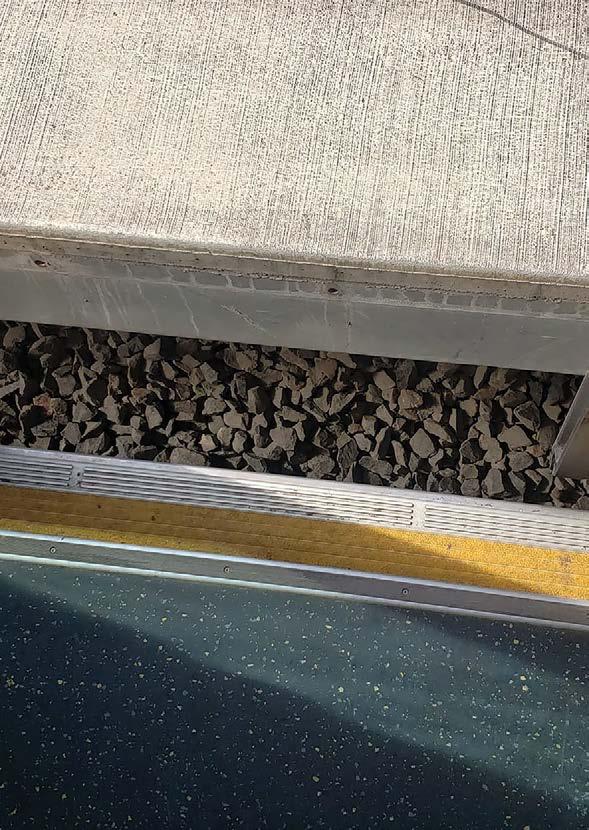

42 RAILWAY STATION PLATFORM GAP SOLUTIONS
Julie Duong,
Sandra Louise, Redfern, NSW
Emma Phelan, West Richmond, VIC

Automated solutions 5/
What if a platform ramp could be:
- automatic
- adjust for depth and height of the gap
- accommodate for stopping inaccuracies of the train by adjusting its position or by being modular?
We tested 3 solutions: -Modtas - Rofraus A-MAR - Rofraus D-MAR
43 RAILWAY STATION PLATFORM GAP SOLUTIONS

Rofraus
44 RAILWAY STATION PLATFORM GAP SOLUTIONS
rofraus@yahoo.com.au


45 RAILWAY STATION PLATFORM GAP SOLUTIONS Rofraus A-MAR Ascending Ramp
Michel Cociuban:



46 RAILWAY STATION PLATFORM GAP SOLUTIONS
Rofraus A-MAR
rofraus@yahoo.com.au


47 RAILWAY STATION PLATFORM GAP SOLUTIONS Rofraus D-MAR
Ramp
Descending
Michel Cociuban:



48 RAILWAY STATION PLATFORM GAP SOLUTIONS
Rofraus D-MAR



49 RAILWAY STATION PLATFORM GAP SOLUTIONS
Rofraus trial video

Modtas
50 RAILWAY STATION PLATFORM GAP SOLUTIONS
Robbie Phelan, info@modtas.com


51 RAILWAY STATION PLATFORM GAP SOLUTIONS MODTAS Moveable Safety Platform
Robbie Phelan, info@modtas.com


52 RAILWAY STATION PLATFORM GAP SOLUTIONS MODTAS Moveable Safety Platform
The Modtas ramp solution being tested


53 RAILWAY STATION PLATFORM GAP SOLUTIONS



54 RAILWAY STATION PLATFORM GAP SOLUTIONS
trial video
Modtas
“When you get off, people are actually pressuring you to get out of the train, it is actually quite nerve wracking”
Research participant, RofRaus trial, 2022


55 RAILWAY STATION PLATFORM GAP SOLUTIONS


56 RAILWAY STATION PLATFORM GAP SOLUTIONS
Feedback about the automated ramps was extremely positive
Average overall first impressions after trial (%, n = 26)
Reactions
“This needs to be implemented at every door.”
“No gap, no issues!”
“Don’t have to wait for the driver.”
“It would literally change my life!”
“Super simple and I felt confident that I can sort myself.”
“It’s just easy, and I don’t like talking to people, so it’s great!”
Considerations
Communication: It’d be good to have more communication, “like traffic lights” so you know when it’s ready to cross.
Automation: “The ramp could be activated with your MYKI system or should be deployed automatically.”
Training: “Metro staff need to be trained on how they work, and what to do if something goes wrong.”
Tactility and High Contrast: Ensure that it is clear where the ramp is, including on wayfinding apps.
Source: La Trobe University, quantitative ramp survey, 2023
57 RAILWAY STATION PLATFORM GAP SOLUTIONS
Very Negative2 3 4 Neither 6 7 8 9Very Positive 0% 0% 0% 0% 0% 4% 8% 15% 69% 4%
How easy was using the automated ramp solution? (count, n = 29)
Board the train
Alight from the train
58 RAILWAY STATION PLATFORM GAP SOLUTIONS 17 17
Extreme difficult
2 3 4 5 6 7 8 9Very Easy 0 0 0 0 0 0 0 1 0 1 3 3 4 2 4 3 2 1
Source: La Trobe ramp trial with People with Disability 2023
How safe did you feel using the ramp? (count, n = 29)
Board the train
Alight from the train
59 RAILWAY STATION PLATFORM GAP SOLUTIONS 19 16
Less safe
2 3 4 5 6 7 8 9Extremely safe 0 0 0 0 0 0 0 0 0 2 1 2 5 1 2 5 3 2
Source: La Trobe ramp trial with People with Disability 2023

“The gradient of the ramp means my wheelchair tips”
–
2023


60 RAILWAY STATION PLATFORM GAP SOLUTIONS
La Trobe Ramp Survey,
Poppy Aggenbach, Bendigo, VIC
Zoe Zamperini, Mortdale, NSW
Did the automated ramp solutions solve the gap issue between platform and train? (%, n = 29)
If this solution used in our public transport system, how much easier or more difficult do you think traveling by train will be? (%, n = 29)
Would you prefer a manual ramp or (an improved version of) an automated ramp? (%, n = 29)
61 RAILWAY STATION PLATFORM GAP SOLUTIONS Solved it completely Neither Not solved at all Much easier Neither Still difficult Automated Manual Both
People
Disability 2023
Source: La Trobe ramp trial with
with
3% 3% 7% 7% 90% 97% 76% 17%

“Definitely too steep, even with a ramp”
–


62 RAILWAY STATION PLATFORM GAP SOLUTIONS
Percy Oliver, Facebook Comments, July 2023
Percy Oliver, Richmond, VIC
Kate Wirges, Malmsbury, VIC
Significant impact
How often will you use train if these solutions implemented in the train stations? (%, n = 29)
Before implemented the automated ramp
After implemented the automated ramp
What
will you do more/new using a train if this is implemented (choose as many as relevant)? (%, n = 29)
63 RAILWAY STATION PLATFORM GAP SOLUTIONS
2023
Source: La Trobe Ramp trial,
More than once a week Once a weekOnce a month A few timesN/A 28% 34% 10% 14% 14% 79% 10% 3% 7% 0% Visit events Appointments (not social, eg a doctor) Social Vistis Work Commute Travel for Relaxation Education Shopping None of the above 83% 72% 66% 55% 83% 69% 59% 3%
“There were times when the key to get the ramp wasn’t available or working. Or the ramp was warped and wouldn’t fold down.”



64 RAILWAY STATION PLATFORM GAP SOLUTIONS
– La Trobe Ramp Survey, 2023
Janice Lovelock, Leura, NSW
Leonard Mammoliti, Eltham, VIC
Gov & Industry feedback
“The Department of Transport has a vision around simple safe and connected transport. Making sure that all journeys are accessible is absolutely core of our vision and what we are aiming to achieve as a state.”
David Martin: Strategic data partnerships at DOT, Victoria.
“My experience here with the solutions presented here today, the AMR and the DMR provided me and my guide dog with very smooth access into the train thanks to the prototypes that were demonstrated here.”
David Simmonds Director of transport accessibility, DOT, Victoria.
‘Ideally, the ramps are integrated with the doors so they become a fully integrated system. And in terms of reliability and throughout time, we’re talking fractions of a second time you have for the ramp to be deployed, it’s the same time that it takes for the door to open. Yes, so in terms of impact on dwell time, it’s almost none yet almost zero. The heart of the issue, which is not so much about dwell time is reliability.
Rail operator
65 RAILWAY STATION PLATFORM GAP SOLUTIONS
“I normally end up just jumping the gap to the platform in my chair”
– La Trobe University, Quantitative ramp survey, 2023


66 RAILWAY STATION PLATFORM GAP SOLUTIONS
Nae Rocca, Coburg, VIC
Unassisted access to trains using automated ramps would solve a major accessibility issue for a wide group of people with disability. What is needed is an assessment of existing ramp prototypes in an operational environment:
Safety 2. Operational efficiency
Reliability
67 RAILWAY STATION PLATFORM GAP SOLUTIONS
Conclusion
next
La Trobe stakeholder interviews 2023 (key evaluation criteria)
1.
3.
and
step Source:
Thank you to the Australian Federation of Disability Organisations (AFDO) and their participants who came from far and away and tested the ramps and gave crucial feedback to help improve the systems. We appreciate their help and generosity.


68 RAILWAY STATION PLATFORM GAP SOLUTIONS
Thank you
i-Move for their guidance and platform:
Renae Leeson and Emilie Alexandre
For getting La Trobe University involved:
Paul Murray at NTRO
Paul Bennett for the assistance on the project
Sam Crees at NTRO for the excellent videos
For giving us time and industry feedback:
Cross River Rail (CRRDA),
Department of Transport and Main Roads Queensland (TMR)
Transport for New South Wales
MetroTrains
Department of Transport Victoria
Department for Infrastructure and Transport South Australia
Rail Industry Safety and Standard Board (RISBB)
For letting us trial their prototypes:
Rofraus: Michel Cociuban
Modtas: Robbie Phelan
For providing lived experience input:
Jim Valavanis, Duncan Steward and all participants
For crowd sourcing gap pictures:
All participants in our facebook platform: https://www.facebook.com/groups/nomoreplatformgap
For the hard work on this project:
Aseel Bervan and Dom Harvey for their tireless work on this research project
Byron Palavikas for – amongst other technical support - driving out to NTRO to fix the ramp while sick just before a demo
Daniel Reynolds for his drive to measure wheelchair gaps
La Trobe I&O for their flexibility to host and store the ramps
69 RAILWAY STATION PLATFORM GAP SOLUTIONS
ABOUT THIS PROJECT
The gap between a railway station platform and any train represents a major hazard and risk for all passengers boarding and exiting trains. This risk is amplified for mobility device users, people with a disability, the elderly and young children. The risk of slips, trips, falls, entrapment, and injury is ever present.
This project provides a fact base to recognise the problem as well as a pathway to a solution by testing proof of concept prototype/s. It is proposed to work closely with mobility device users and other vulnerable road users, to test and assess:
• effectiveness for a range of existing platform gap solutions; and
• a modular, automatic ramp that can be placed permanently on the platform (or train carriage) and only rise and/or extend when needed.
Have our articles emailed to you right as we publish them!
Receive a notification by email, with a link to our project news and articles straight after we publish them. Nothing else, just our articles, so you can stay on top of what iiMOVE is doing.
Participants
Australasian Centre for Rail Innovation (ACRI)
La Trobe University‘s Centre for Technology Infusion
Project background
In order to minimise risks involved with the platform gap railway staff often manually deploy portable access ramps at designated locations along the station platform, which can be a confusing process for many in a busy station environment. In recent years various suppliers have commercialised fixed rubber block products to the platform edge to minimise the gap.
However, the fixed nature of these platform gap products means that some form of vertical and horizontal gap or offset is often present given the broad range of different passenger and freight train rolling stock operating on the rail networks. An effectiveness study similar to what was done with earlier research from ACRI on entrapment risk for mobility devices at rail flange gaps is proposed. Collating definitive evidence of entrapment risk and ease of navigation will entail:
• production of a mock adjustable station platform to train floor jig
• design and conduct a laboratory experimental matrix program examining different horizontal and vertical gap combinations with and without platform gap products and a range of able-bodied pedestrians, lived experience pedestrians, mobility device users and lived experience mobility device users
• This will also be supplemented with a series of survey and/or interview questions of the participants of the lab study. In parallel to the iMOVE project ACRI and DoT Victoria will work with the MODTAS and ROFRAUS teams to develop/refine working prototype/s of the automated ramp concepts that allows for mobility impaired commuters to board and alight from trains unassisted.
The mobility access ramp prototypes promise to close the vertical and horizontal gap between the train and platform, allowing uninhibited access and egress for all commuters in particular those with impaired mobility, parents with prams, children, and mobility aides. The prototype automated ramp system/s will also be included in the lab entrapment risk experiments. Options to undertake the lab experiments at a relevant industry exhibition are currently being explored. ACRI, DoT Victoria, and other rail industry partners are also working together to test (in at least shadow mode) at a representative station platform/environment.
Project objectives
The objectives of this project were to:
Generate objective evidence of which scenarios the different platform gap filler products are suitable for use in.
Demonstrate and measure the effectiveness of the automated ramp prototypes in the same variety of scenarios.
Provide an objective understanding of the effectiveness and characteristics of the various platform gap solutions will be useful for rail industry organisations to inform business case drivers for example deciding to deploy an automated ramp option versus manual ramp versus fixed rubber block type option/s.
Propose solutions for enhanced accessibility for all commuters at train station platforms, which is a critical component of the future compliance requirements for new and existing train station platforms and this work will significantly advance the cause.
70 RAILWAY STATION PLATFORM GAP SOLUTIONS
Methods
Research methods
Ramp survey: Survey on the manual ramp solution
Facebook page was created to get insights about how big the issue of the gap between platforms and trains in Australia.
Rofraus Trials – La Trobe University
Rofraus Trials – NTRO
Date
Number of participants
30/01/2023-30/09/202381
3/08/2022- 30/10/2023 162 members- Photos of 85 locations have been uploaded.
23-24/11/2022 11
23/02/2023 8
ATSA Independent Living Expo participation to get feedback on international gap standards and Australian standards. 24-25/05/2023 21
Modtas Trial- Bayswater 13-14/09/2023 9
Cross River Rail (CRRDA),
Industry engagement Nov. ‘22 – May ‘23
Department of Transport and Main Roads Queensland (TMR) Transport for New South Wales MetroTrains
Department of Transport Victoria
Department for Infrastructure and Transport South Australia Rail Industry Safety and Standard Board (RISBB)
71 RAILWAY STATION PLATFORM GAP SOLUTIONS
References
Miscellaneous
Title Page: Leonard Mammoliti, Southern Cross, VIC, July 2023
https://www.exhibitionparkincanberra.com.au/event/canberra-atsa-independent-living-expo-2023/
https://www.enable-access.com/product/aerolight-axr/
https://www.9news.com.au/national/hundreds-of-people-tripping-and-falling-near-trains-in-melbourne/fc4ca764-1d73-4d66-9372-4df775677d68
https://www.researchgate.net/figure/Manual-mobile-Ramp-Port-a-Ramp-UK-bridging-the-gap-between-the-train-and-the-platform_fig3_344042662
Train-mounted ramps
https://www.ptua.org.au/category/news/page/2/
https://www.delkorrail.com/platform-gap-filler
https://www.levelboarding.org.uk/open-letter-to-greater-anglia/
https://www.masats-llc.com/en/rt1-dual-telescopic-ramp/
https://www.palfinger.com/en/products/passenger-lifts/models/mbb-trainlift_p_1921
Platform-mounted ramps
https://www.alpharail.com.au/
https://railgallery.wongm.com/melbourne-rail-accessibility/F112_5710.jpg.html
https://www.atlasobscura.com/places/14th-street-union-square-moving-platforms
https://fb.watch/ogCOiCiYc1/
72 RAILWAY STATION PLATFORM GAP SOLUTIONS



OFFICES IN: Adelaide, Brisbane, Canberra, Launceston, Melbourne, Perth, Sydney, and Wellington CONTACT FOR MORE INFORMATION NATIONAL TRANSPORT RESEARCH ORGANSATION E: info@ntro.org.au | P: +61 3 9881 1555 W: NTRO.ORG.AU | A: 80A Turner St. Port Melbourne, VIC 3207














































































